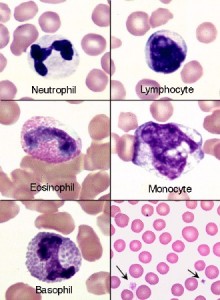Feline neutrophils contain barely discernible granules (the cytoplasm is colorless). Low numbers of small Dohle bodies may be seen in some neutrophils. Lymphocytes are generally small and put to 10% may have red cytoplasmic granules (granular lymphocytes, which are cytotoxic T cells or natural killer cells). Neutrophils outnumber lymphocytes in healthy cats. Eosinophils are distinctly rod-shaped and, unlike other species, lack myeloperoxidase. Monocytes are similar to other species. Basophils have lavender granules, which can be quite difficult to visualize. Red blood cells are smaller than dogs and have a small amount to no central pallor. A few keratocytes can be seen in healthy cats and many non-anemic cats have a few Heinz bodies (so-called “endogenous” Heinz bodies) that are difficult to visualize in a Wright’s stain (they are easier to see in a new methylene blue-stained smear). A few polychromatophils and macrocytes (corresponding to aggregate and punctate reticulocytes) may be seen in non-anemic cats, along with a few Howell-jolly bodies (micronuclei, nuclear remnants). Platelets (arrows, lower left panel) are quite variable in size, more so than other species, and many platelets can be large. Platelets clump readily in cats, making it difficult to obtain accurate platelet counts.

